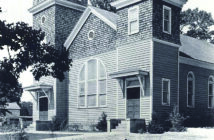“A good education is the most valuable gift that no one can take from you,” said Jay M. Ipson, Holocaust history lecturer and co-founder of the Virginia Holocaust Museum.
Ipson has lectured to thousands over the last 30 years teaching tolerance through education. The 80-year-old Holocaust survivor’s mission in life is to educate and teach adults and new generations of children on the atrocities of the Holocaust, its history and its aftermath so it is not forgotten, thereby preventing the recurrence of genocide in the future anywhere in the world.
In May he was guest lecturer for 400 history students at Thomas Dale High School. Genocide and the Holocaust are mandatory studies for the Virginia SOLs. History teacher Kevin Tucker had invited Ipson to speak to his sophomore history classes about his story. The opportunity was open for all history class students to attend the lecture. Ipson’s last visit to Thomas Dale High School was in 2013.
Ispson returned to Thomas Dale last week to accept a painting from sophomore history student, Celine Siecrest. The painting was the result of a self-directed project, a reflection of their studies, and the final requirement for the 10th grade history class.
Siecrest, whose family is half Polish, said she thinks about the Holocaust all the time. Tucker was aware of Siecrest’s talent for drawing and suggested she do a painting for her project. In shades of gray, her painting tells the story of Ipson’s father and how, as a businessman during the Nazi invasion of Lithuania, he lied and changed his vocation so that his family would survive. He and his family, along with thousands of Jews, could have been dressed in a striped uniform and sent to a concentration camp. The painting shows the reflection of a man in a work uniform, who helped save his family. She painted a wrench lying in the sink under the mirror that serves as a symbol for Ispon and how he and his mother and father survived the Holocaust.
Ipson said his father knew nothing about handling a wrench or working as a mechanic but said he told the Germans he did, knowing the German’s needed mechanics to repair their vehicles.
Tucker suggested that Siecrest give the painting as a gift to Ipson. “It is the most powerful piece of work ever turned in for their self-reflection project,” he said.
Siecrest said, “It is an honor to give the paining to him.”
The emotions never change for Ispson with the honors and gifts he has received over the years during his mission to share his story of his family’s survival during the Holocaust. A small wrench he wears as a tie clip, and one he keeps close to his heart servie as a testimonial to his family’s survival.
Upon receiving the painting he said, “It [the painting]does not give you overall joy because it was a bad time, but it brings it [genocide]back to the forefront, which is what is happening in the world today. Today it is happening to the Christians [referring to the wars in the Middle East]; What have we learned?”
“Meeting students like her, the future will change; she will pass the story on to her children and her grandchildren.”
“We need to keep in mind that an atrocity such as the Holocaust can happen anywhere. We need to keep vigilant. You can lose your freedom overnight if you don’t monitor the government and hate groups. It is always possible for a leader of a hate group to get elected.
“Most of these places know nothing of the Holocaust, or care about it. Only by means of education, and when the religions of the world learn to live with one another, this will stop.
“When the human beings will learn that we all bleed red and have but a limited time on this Earth and realize that with peace we accomplish more than with war, and that all religions have a right to exist, then there will be peace on Earth.”

